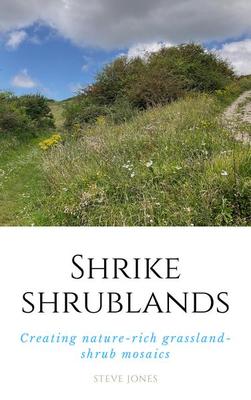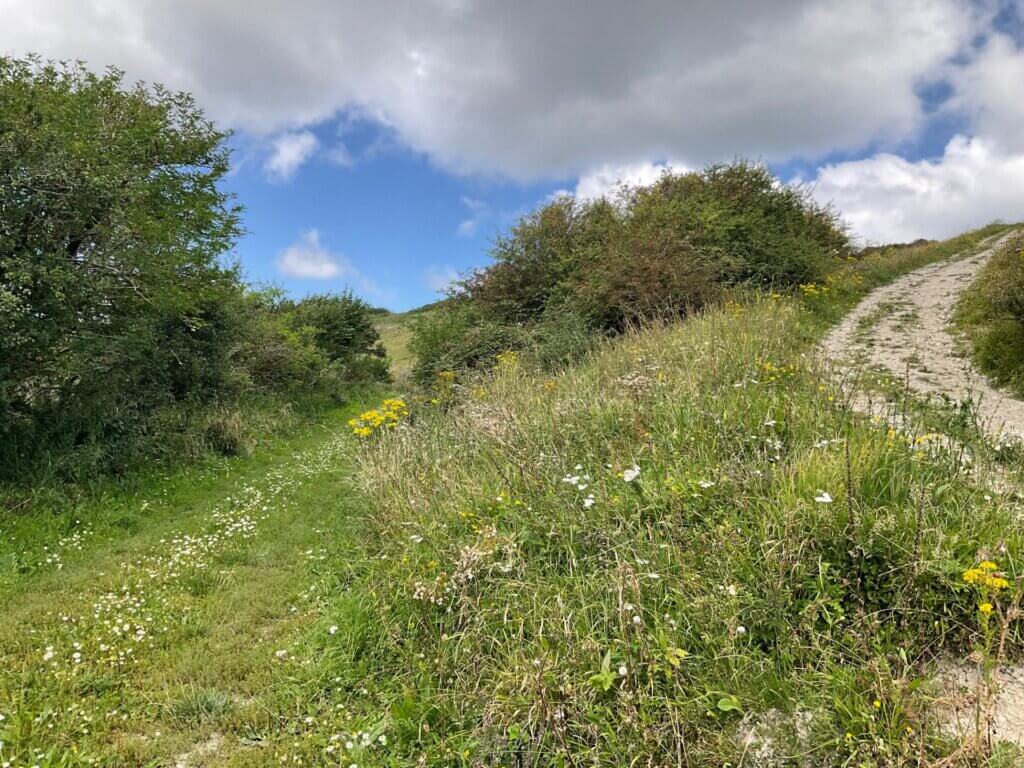

‘Scrub’ has a surprisingly bad reputation in UK conservation and farming. It’s a feature that ‘invades’ prized grassland and must be tackled by ‘scrub-bashing parties’ of well-meaning volunteers. Farmers can even get penalised for harbouring the stuff, losing area payments if native shrubs appear in their otherwise bleak improved pasture. Don’t get me wrong: a lovely patch of chalk grassland SSSI near me has been wrecked by unchecked shrub colonisation over the last two decades. But mosaics of species-rich grassy-shrublands can be wonderfully rich in wildlife, including many species of conservation concern. And they can fit in very well with livestock systems, provide perhaps grazing and browsing habitat for rare livestock breeds and provide much-appreciated spreading space for people.
Why do I call these places ‘Shrike Shrublands’? A few years ago I looked at how we might get Red-backed Shrikes back into southern England. I visited the Knepp Estate and various other ‘shriky’ places. We have pockets of nice habitat but no shrikes. Looking at sites that do have shrikes, it quickly became obvious that what makes a grassy-shrubland good for a colony of nesting Red-backed Shrike also makes such an area incredibly valuable for all manner of species.

The perfect Red-backed Shrike territory demands a number of key elements. Put those elements together and scale-up so the site can support a number of territories and you have a Shrike Shrubland of immense wildlife value.

And this is a habitat that’s straightforward to create relatively quickly. We are missing numerous opportunities to create large blocks of it. The infuriating habit of planting wall-to-wall whips – nursery transplants – of trees and shrubs bypassed the all-important grassland-shrubland mosaic stage of natural ecological succession. A carefully created Shrike Shrubland can be a precursor to three long-term habitats: new, naturally-structured native woodland; wood pasture; and, of course, more stable grassy-shrublands.
So what exactly does our habitat ambassador, the Red-backed Shrike, look for in the perfect territory? Well, they have an inordinate fondness for beetles, especially dung beetles. Those associated with cattle dung are prized. We can’t bring back Aurochs but domestic cattle dung is just as good – provided it’s free of toxic anti-parasitic drugs. As a scan-and-pounce type hunter, the Red-backed Shrike needs open grassland with numerous, but widely scattered and small patches of shrubs. And these must provide access to a mosaic of disturbed ground, tightly grazed lawns and tussocky, flower-rich grassland within easy scanning distance.

That flower-rich attribute is vital: shrikes also love bumblebees and other Hymenoptera. The site must have a species-rich succession of flowering herbaceous wildflowers and shrubs drawing in the pollinators.
The tightly grazed lawns and disturbed ground are key to food accessibility and can be generated by Rabbits. Non-native but such a good habitat creator. An early intervention, if your shrubland creation site is very open (say a large arable field) is to distribute brash piles across the site. These will hopefully draw-in Rabbits and initiate warren creation, with the ground vegetation heterogeneity following as the habitat develops. Make sure you have plenty of flower-rich taller swards too, as these will fill up with grasshoppers, and shrikes love Orthoptera.
If you are starting with a large arable field, rough it up a bit. Dig some scrapes and build some low mounds of friable soil with south-facing cliffs. Block any in-field sub-surface drainage to re-ignite lost seepages. Dig clean-water pools. These will draw in another favoured shrike food resource: dragonflies and damselflies.
It’s easier to develop the flower-rich component of a Shrike Shrubland if you start with arable. Here, you can spread green hay full of wildflower seeds. You just want to speed the process up and ensure flowering herbaceous plants can get a toe-hold in the early years.
If native shrubs are on site or nearby, they’ll colonise. But, again, to speed things up, plant Bramble cuttings (maybe under those brash piles) and small groups of thorny shrubs: Field and Dog Rose, Blackthorn, Hawthorn etc. Just make sure these are small clumps and widely scattered: from a shrike perspective these are the vantage points from which to hunt and a place to conceal the nest. Plant a Crab Apple or Wild Pear in one or two clumps too.
What about long-term management? If your Shrike Shrubland is on your farm use cattle to graze it lightly, with a bit of grazing in summer to ensure those dung beetles have enough to eat. Don’t worry about deer: they’ll sculpt shrub clump development rather than preventing it entirely, in the southern England lowlands at least. If you’re aim is to develop wood pasture, you could do much the same – year round very light grazing with cattle, ponies, rare and local breeds. If you want to create a structurally complex native woodland in the long-term, very, very light grazing and browsing for the first decade capitalises on the early successional grassland-shrubland phase whilst allowing native trees and shrubs to get establish. Occasional grazing by cattle and ponies in the longer-term will mimic the movements of herds of Aurochs and Wild Horses. And, if at all possible, champion Wild Boar. These wonderful, neglected natives create the patches of bare ground much loved by hunting shrikes and maintain habitat heterogeneity at a small scale.
Given the amount of ‘woodland’ planting we’re doing in southern England, we could be creating a shifting mosaic of Shrike Shrublands across the region if only we could avoid so much uncompromising whip planting.
Such places will likely support Turtle Doves, Cuckoos, Nightingales, Hedgehogs, feeding bats, Glow Worms, Adders and all manner of species.
Will they support Red-backed Shrikes? Well, their population has shown signs of increase on the near-continent in the last few years. Maybe we’ll begin to see more spring arrivals if they begin to saturate habitat in France, Netherlands etc. If we provide the habitat, perhaps they will come. Perhaps we’ll see the sustained return of the Butcher Bird.
[registration_form]
Thank you Steve for an excellent post. I have your booklet and find it a great source of information and inspiration, there are so many great nuggets in there, as there are in this post.
I have been advocating for decades for the creation of scrub (or shrub) mosaics on nature reserves, Community Forests and Woodland Trust sites with minimal success. I am not sure why there was/is so much reluctance. Any naturalist worth their salt knows the value of such rich habitats. There is, of course, the incentives provided by the Forestry Commission grants to plant standard trees close together to promote wood production that may have really influenced mind sets. Also people naturally love the tall woodlands that they may eventually (50+ yrs time), but what about the mean time where we can have the rich, open-gladed scrubland, full of insects and birdsong.
I had a very positive meeting with the Borders Forest Trust last week on this subject. On newly acquired land around The Devils Beeftub near Moffat they will plant and encourage 20-30 acres of open scrubland below the tree planted slopes. We may not get shrikes but the I bet they will be richer in wildlife in the coming years than the slopes above.
Recently the Woodland Trust have evolved in their outlook and have produced an excellent online Woodland Creation Guide that highlights the value of scrub, natural regeneration and early successional habitats:
https://www.woodlandtrust.org.uk/plant-trees/woodland-creation-guide/?gad_source=1&gclid=Cj0KCQiA-62tBhDSARIsAO7twbYspM0A_9Ck41wTNXYsVT9TJWcfYfQ5SJ-M-FnECQIXGcI-_CwAKTcaAj68EALw_wcB
Great news the WT are FINALLY starting to look at creating proper woodland rather than just digging in as many trees as possible in a tight space. Some of their big community tree planting days looked as if someone was putting in a new Sitka spruce plantation rather than create a new wood – trees planted equidistantly in geometric patterns!!! There’s an organisation called Mossy Earth that’s recently starting doing pilot projects to reinvigorate (or maybe invigorate is more appropriate?) tree plantings of yester year which have just created desperately depressing gloomy thickets – more of the standard than exception unfortunately, hope that’s changing.
Great stuff Steve. Happy memories of a scorchio day on IoW looking at potential Chough sites (any news?). All the best for 2024. Rich
Richard – thank you!
Thanks, Steve.
I’ve been banging on about this for the past 10 years, ever since I saw the habitats red-shrikes are abundant in, in our ‘secret corner’ of south-east Poland. This area is ideal for seeing what the British Isles probably once looked like, as the species present are largely the same as we have, or had, in the British Isles.
I take people, especially ecologists, to see this stuff so they can both understand how much we’ve lost and how we can quite easily get much of it back. Sadly, most ‘ecologists’ have never seen biodiverse landscapes directly comparable to what we once had, and therefore have no chance at understanding the rich ecosystems we should have and how to recreate them.
Follow the link to the ‘log’ from on of our trips!
Absolutely brilliant blog Steve!!! My heart sinks when I see a ‘new’ wildflower meadow that consists of a large field of long grass, but no bushes or ponds, very limited as a habitat when it’s one massive one rather than many micros. The point about brash piles helping rabbits get established was a new one to me so thanks for that too.
Thank you for your wonderful letter. It took me back to when I was a young person, discovering and experiencing flora and fauna, (especially the bees, dragon and damselflies, moths and butterflies). Not having good eyesight I could not appreciate the birds, (they came later). Walking on Chalk grassland was wonderful, seeing the Thrush Anvils along the paths, and the grassland flowers. Then the New Forest, sandy soils, heather and gorse, with it’s associated woodlands where primroses and Bluebells flourished, along with Wild Sorrel. And the peaty moorland of Dartmoor, Exmoor and Bodmin Moor.
Good memories for a now elderly and disabled person.